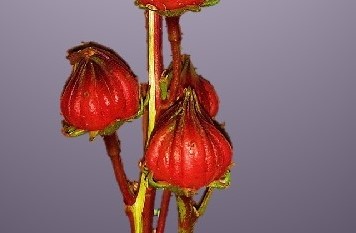Naturalization of Hibiscus sabdariffa L. in the transition region of the Pantanal, Amazon Forest and Cerrado Biomes
DOI:
https://doi.org/10.20873/jbb.uft.cemaf.v11n2.valentimKeywords:
Naturalized species, Vinegar, Furcaria SectionAbstract
The species Hibiscus sabdariffa L. is originally from the African continent. It is a bushy species that can reach up to 2 m in height, where due to its various uses, it has spread to different regions of the world, where it acts in an exotic way, and can become a naturalized species. In the city of Cáceres-MT there is a small population of the species in an anthropized area, in which, according to local residents, the plants have been present in the place for several years, even with the occurrence of disturbances in the area several times. Therefore, the objective of this work was to analyze the possible naturalization of Hibiscus sabdariffa in an anthropized locality present in the transition region of the Pantanal, Amazonian Forest and Cerrado Biomes in the city of Cáceres- MT. For the execution of the work, a qualitative research was carried out, of an exploratory and descriptive nature, and bibliographical research on Hibiscus sabdariffa and on the naturalization of plants. Data on disturbances were collected through observations over the years and through interviews with small producers residing in the community. The small population of the Hibiscus sabdariffa species found in the rural community in Cáceres- MT has the characteristics of naturalization, and can therefore be considered a naturalized species in the place and participant of the local biodiversity. In addition, the fact that the species has been present in the area for several years, despite recurrent disturbances, reinforces the occurrence of naturalization.
References
Batista EC, Matos LAL, Nascimento AB. A entrevista como técnica de investigação na pesquisa qualitativa. Revista In-terdisciplinar Científica Aplicada, v.11, n.3, p.23-38, TRI III, Blumenau- SC, 2017. https://doi.org/10.13140/RG.2.2.10084.09608
Botrel N, Madeira NR, Melo RAC, Amaro GB. Vinagreira. Embrapa Hortaliças, Brasília- DF, 2017.
Cáceres. Prefeitura Municipal de Cáceres/MT. Prefeitura faz balanço positivo da campanha contra as queimadas e celebra diminuição de focos de calor. 2021. Disponível em: <https://www.caceres.mt.gov.br/Noticias/Prefeitura-faz-balanco-positivo-da-campanha-contra-as-queimadas--e-celebra-diminuicao-de-focos-de-calor-8314/>. Acesso em: Setembro, 2022.
Camillo J. Vinagreira (Hibiscus sabdariffa L.). 2016. Dispo-nível em: <https://www.aplantadavez.com.br/2015/05/vinagreira-hibiscus-sabdariffa-l.html> . Acesso em: Agosto, 2022.
Coelho CA, Amorim BS. Expandindo a distribuição geográfi-ca de Hibiscus sabdariffa L. (Malvaceae): uma espécie natu-ralizada e negligenciada para a flora brasileira. Hoehnea, v.46, n.1, p.1-7, 2019.
http://dx.doi.org/10.1590/2236-8906-101/2018
Coutinho TS, Fernandes-Júnior AJ. Hibiscus in Flora e Funga do Brasil. 2020. Jardim Botânico do Rio de Janeiro. Dispo-nível em: <https://floradobrasil.jbrj.gov.br/FB9079>. Aces-so em: fevereiro, 2023.
Esteves GL, Duarte MC, Takeuchi C. Sinopse de Hibiscus L. (Malvoideae, Malvaceae) do Estado de São Paulo, Brasil: espécies nativas e cultivadas ornamentais. Hoehnea, v.41, n.4, p.529-539, 2014.
http://dx.doi.org/10.1590/2236-8906-10/2014
Fagundes GE, Massunaga N. Ações terapêuticas da planta Hibiscus acetosella Welw. ex Hiern. Revista Brasileira de Nutrição Funcional, v.15, n.65, p.13-18, 2016.
Freitas JG, Gomes VGN, Flores LNP, Batista FRC. Coleta de Material Botânico (Guia prático). Instituto Nacional do Se-miárido- INSA, Campina Grande- PB, 2021.
Gil AC, Métodos e Técnicas de Pesquisa Social. Editora Atlas; 6ª ed. 2008.
IBGE - INSTITUTO BRASILEIRO DE GEOGRAFIA E ESTATÍSTICA; Cáceres. 2019. Disponível em: < https://cidades.ibge.gov.br/brasil/mt/caceres/panorama>. Acesso em: Março, 2023.
Instituto Chico Mendes de Conservação da Biodiversidade ICMbio. Estação Ecológica de Taiamã. 2022. Disponível em: <https://www.icmbio.gov.br/esectaiama/quem-somos.html>. Acesso em: Agosto, 2022.
Krapovickas A, Fryxell P. Las especies sudamericanas de Hibiscus secc. Furcaria dc. (Malvaceae-hibisceae). Bon-plandia, v.13, n.1/4, p.35-115, 2004.
https://doi.org/10.2307/41941259
Mack RN, Simberloff D, Lonsdale WM, Evans H, Clout M, Bazzaz FA. Biotic invasions: Causes, epidemiology, global consequences, and control. Ecological Applications, v.10, n.3, p.689-710, 2000.
https://doi.org/10.2307/2641039
Moro MF, Souza VC, Filho ATO, Queiroz LP, Fraga CN, Rodal MJN, Araújo MFS, Martins FR. Alienígenas na sala: o que fazer com espécies exóticas em trabalhos de taxono-mia, florística e fitossociologia? Acta Botanica Brasilica, v.26, n.4, p.991-999, 2012.
https://doi.org/10.1590/S0102-33062012000400029
Matos DMS, Pivello VR. O impacto das plantas invasoras nos recursos naturais de ambientes terrestres – alguns casos bra-sileiros. Ciência e Cultura, v.61, n.1, p.27-30, 2009.
Pastore M, Rodrigues RS, Bianchini RS, Filgueiras TS. Plan-tas exóticas invasoras na Reserva Biológica do Alto da Serra de Paranapiacaba, Santo André- SP: Guia de campo. Institu-to de Botânica, São Paulo- SP, 2012.
Rigueiral LHG, Gonçalez VM, Duarte CM. Espécies nativas de Hibiscus (Malvoideae, Malvaceae) da Região Sudeste do Brasil. Rodriguésia, v.70, p.1-19, 2019. http://dx.doi.org/10.1590/2175-7860201970033
Santos ES. Espécies vegetais exóticas em Sergipe: Aspectos fitogeográficos, normativos e socioambientais. 2020. 140p. Dissertação (Mestrado em Desenvolvimento e Meio Ambi-ente) - Universidade Federal de Sergipe, Sergipe.
Schneider AA. A flora naturalizada no estado do Rio Grande do Sul, Brasil: Herbáceas subespontâneas. Biociências, v.15, n.2, p.257-268, 2007.
Silva GS, Rêgo AS, Leite RR. Doenças da vinagreira no Estado do Maranhão. Summa Phytopathologica, v.40, n.4, p.378-380, 2014.

Downloads
Published
How to Cite
Issue
Section
License
Copyright (c) 2023 Sebastião Marcos Silva Valentim, Petterson Baptista da Luz , Elaidy Laura Oliveira Cardoso, Gabriel Moretto, Antônio Carlos Silva Moreira, Anna Júlia Cardoso Amaral, Bruna Samy de Oliveira Miranda

This work is licensed under a Creative Commons Attribution 4.0 International License.
Copyright (c) 2024 - Journal of Biotechnology and Biodiversity

This work is licensed under a Creative Commons Attribution 4.0 International License.
Authors who publish with this journal agree to the following terms:
Authors retain copyright and grant the journal right of first publication with the work simultaneously licensed under a Creative Commons Attribution License (CC BY 4.0 at http://creativecommons.org/licenses/by/4.0/) that allows others to share the work with an acknowledgement of the work's authorship and initial publication in this journal.
Authors are able to enter into separate, additional contractual arrangements for the non-exclusive distribution of the journal's published version of the work (e.g., post it to an institutional repository or publish it in a book), with an acknowledgement of its initial publication in this journal.
Authors are permitted and encouraged to post their work online (e.g. in institutional repositories or on their website) prior to and during the submission process, as it can lead to productive exchanges, as well as earlier and greater citation of published work (Available at The Effect of Open Access, at http://opcit.eprints.org/oacitation-biblio.html).


